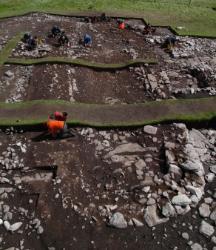Viking Unst project phases
2006 Excavation
Previous work on the site has included an extensive survey of the area (Bond et al. 2006), and the excavation of a small trial trench within the upper room of the house, carried out by Stummann Hansen (2000). Two structures were identified during the survey of the area, but the excavation focused on the preliminary assessment of House 1, with the aim of providing an understanding of the use of the structure, both in terms of the cultural and economic evidence recovered.
The preliminary excavation revealed a sub-rectangular building divided internally into an upper and lower room aligned roughly N-S downslope, with the remnants of double faced walling interpreted as part of a later addition to the structure.
The excavation of the deposits enclosed within the upper room located the extent of Stummann Hansen’s trial trench, which was re-excavated. The bottom of this trench revealed in situ ashy deposits interpreted as occupation surfaces. An assessment of the deposits from the lower room revealed what appeared to be a homogenous infill to the structure, as well as an intriguing gully feature cut into the bedrock. Excavation around the external area of the structure did not reveal any midden or yard deposits.
Publications
Bond, J.M., Maher, R. & Brown, L.D. 2006. Report on Penmap surveys and GIS studies of possible Viking/Norse house sites on Unst, Shetland. January 2006. A report for Shetland Amenity Trust. Unpublished.
Bond, J.M., Outram, Z. & Freeth, C.M. (eds.) 2006. Viking Unst Project. Excavations at Hamar: Field Season 2006. Interim Report No. 1 (Data Structure Report). Bradford Archaeological Sciences Research 18. Bradford: Department of Archaeological Sciences/Shetland Amenity Trust.
2007 Excavations
Hamar
The excavation of House 1 continued and three new areas were opened up to look at a potential yard wall associated with the structure. The assessment of House 2 (to the northwest of House 1) would provide a second dataset of cultural, environmental and chronological information that could be directly compared to the information from House 1, allowing an understanding of the use of the site as a whole.
Underhoull
Excavations carried out by Small (1966) revealed an Iron Age soutterain, sealed by a Norse longhouse, located downslope from the broch tower. The survey carried out by Bond et al. (2006) identified a second longhouse structure adjacent to the broch, which formed the focus of the excavations carried out here in 2007. The aims of the preliminary excavations were to assess key areas of the site, and to collect material for both environmental and chronological analysis.
Publications
Bond, J.M., Outram, Z. & Freeth, C.M. (eds.) 2007 Viking Unst Project. Excavations at Hamar and the Upper House, Underhoull: Field Season 2007. Interim Report No. 2 (Data Structure Report). Bradford Archaeological Sciences Research 19. Bradford: Department of Archaeological Sciences/Shetland Amenity Trust.
2008 Excavations
Hamar
Excavations at House 1 showed that there were many more phases to the structure than surveys and studies prior to full excavation had suggested (see e.g. Stummann Hansen 2000, Bond et al. 2006).
The latest (as yet undated) occupation seems to have utilised only part of the upper room, with a dividing wall and post setting forming a smaller space at the northern end. A stone setting running north-south parallel to the eastern long wall suggests the possibility of a sprung floor and a stone setting and burning part way up the wall on the western side indicate a possible corner hearth or oven. Work at House 2 demonstrated that there was a drain or gully on the hillward side of the building, presumably to drain hilllwash away from the walls of the house.
Excavation of the interior revealed a flagged surface and a small patch of burning, which was sampled for archaeomagnetic dating.
Underhoull
Investigation of the structure showed that it was constructed with a stone frontage on the southern long wall and western gable whilst the northern, upslope side had a turf and stone construction with a gully running along the northern long wall. The southern side of the building faces down slope and towards the sea and so would be the most exposed face. The southern side is also the most likely direction of access to the structure.
The two annexes flank the entrance on the southern side and there are areas of flagging here also. It is quite similar in plan to the original house excavated at Underhoull (Small 1966).
Publications
Bond, J.M., Outram, Z. & Freeth, C.M. (eds.) 2008 Viking Unst Project. Excavations at Hamar and the Upper House, Underhoull: Field Season 2008. Interim Report No. 2 (Data Structure Report). Bradford Archaeological Sciences Research 20. Bradford: Department of Archaeological Sciences/Shetland Amenity Trust.

